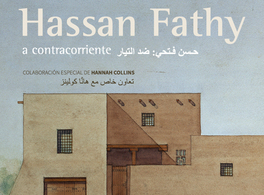Architecture for the Poor: An experiment in rural Egypt
Ediciones Asimétricas has published its third book on Egyptian architect
Hassan Fathy. In the book, Fathy himself recounts his experience in the
conception, planning, design and construction of New Gourna.
July 09, 2021
MADRID
It is, therefore, a story of great aspirations: the attempt to improve society through architecture by working on environmental sustainability, the use of local materials and techniques, and the involvement of the inhabitants in construction as a means of empowerment. It is also the story of a relative failure, attributable not to the architect himself but rather to the story forming the backdrop of the project: the red tape, the lack of resources and the stubborn ways of those for whom it was intended prevented total success, although this did not invalidate some of the truly courageous ideas it expressed. In addition to being an exciting and vivid chronicle, the book presents this experience as one which could be repeated elsewhere, and, therefore, with potential applications in similar situations. Francis Diebedó Kéré, whose activities and attitudes run parallel to Fathy’s, has written an introduction containing well-chosen words. The specialized media’s ongoing interest in both of these architects demonstrates that the path towards sustainable architecture created by Fathy is still fully valid, as his ideas promote a true architecture of dignity.
Hassan Fathy (Alexandria, 1900-Cairo, 1989), an intellectual committed to the cultural renewal of his country by improving habitats of the rural poor, whose living conditions did not seem to have changed since the days of the Pharaohs, is the most influential Egyptian architect ever and the one who continues to arouse the most interest. He was educated under the eclecticbeaux-arts system of his era, to which he would later add the influence of International Style. He soon realized that the methods of those schools were inadequate for Egypt’s economic, social and climatic conditions. The solution to the rural housing problem there could not be industrialization, new materials and air conditioning, but rather self-building techniques based on local crafts and materials with passive heating and cooling methods. Fully devoted to this mission, he participated in international debates, the launch of the Aga Khan Prize and the creation of the Institute of Appropriate Technology. In 1884, he received the Gold Medal from the International Union of Architects. Today he is considered one of the pioneers of environmentally sustainable and socially responsible architecture.
Arquitectura para los pobres. Un experimento en el Egipto rural
ISBN: 978-84-17905-77-4
Format: 15 x 21 cm.Pages: 308
Binding: Paperback with flaps
Retail price: €24 (including VAT)
Foreword by Francis Kéré
Translation by Cristina Ramos
Collection and cover design Toni Cabré
Design and layout Emilio Ramírez Torrescusa

